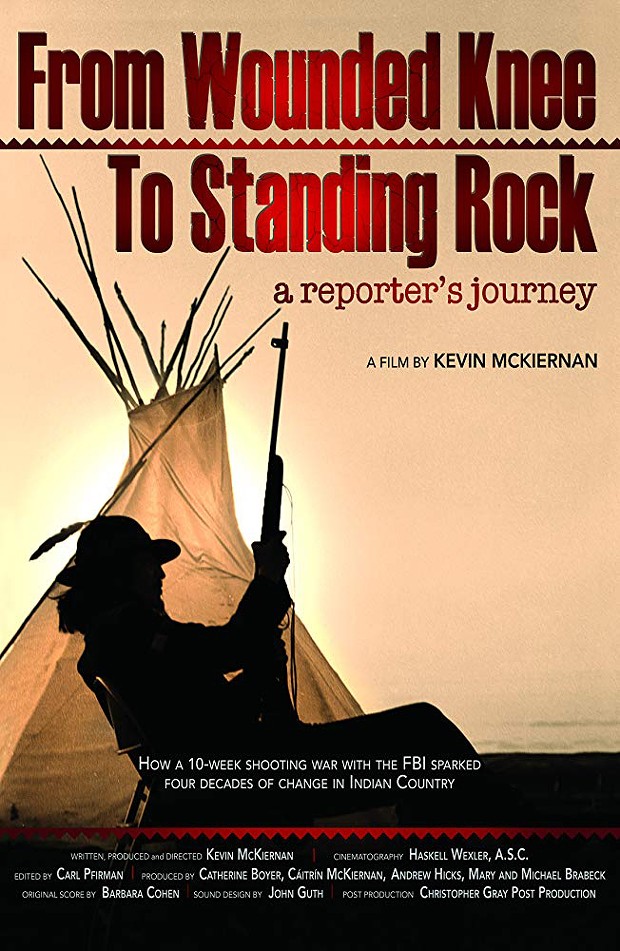Through the Eyes of Native Activists
Kevin McKiernan's From Wounded Knee to Standing Rock
By André Cramblit
From Wounded Knee to Standing Rock.
[
{
"name": "Top Stories Video Pair",
"insertPoint": "7",
"component": "17087298",
"parentWrapperClass": "fdn-ads-inline-content-block",
"requiredCountToDisplay": "1"
}
]
I started my review of From Wounded Knee to Standing Rock: A reporter's journey, screening at the Eureka Theater on Oct. 19, with some trepidation because of its local connection. Journalist and director Kevin McKiernan's documentary looks at Indian actions at two different points in history. It focuses partly on the American Indian Movement, the grassroots movement founded in Minneapolis in 1968 that radicalized Natives agitating to improve conditions for impoverished urban Indians.
Seeking to hide leaders who were being pursued by the FBI, members of AIM came to Northern California Indian Country looking for sanctuary. Their reception was not a warm one, as they brought with them the notion that to be a true Native you had to do the Sun Dance and sweats in the tradition of plains tribes. Local American Indians, connected with our own cultural ceremonies and ways of doing things, had little tolerance for this kind of "my way or the highway" attitude and AIM moved along into Oregon seeking asylum in friendlier territories. Personally, this, along with a college confrontation with AIM leader John Trudell, has left me with a bad taste in regard to the group.
Nonetheless, I watched the movie eager to see what light could be shone upon the dismal conditions of American Indians who have been trapped in poverty, low educational attainment, poor health and a life span shorter that of their fellow Americans — 5.5 years shorter, according to the federal Indian Health Service.
The movie gives an overview of the Wounded Knee occupation in the bitter winter of 1973 on the Pine Ridge Reservation. This is when the divided Oglala Sioux Tribe from that area broke into separate factions and a call was sent out to AIM specifically, and American Indians in general, to come to the site to help support the seizure of the tribal village.
The dispute was against the tribal council, which was accused of using abusive tactics against its opponents and not adhering to traditional ways of conducting business. The council was supported by the U.S. government, which sent in armed FBI agents, federal marshals and the National Guard in a military approach to resolving the exploding conflict. It was reported later that the Army was also involved.
While AIM was not well received in the local Northwest California American Indian enclaves, the film shows they did have support among individual tribal members from our community. It's not surprising — I have a cousin who went to fight the oppression of the tribal council and the military might that supported them in the standoff. This documentary prominently features local Yurok Tribal member Willard Carlson, who shares recollections of his experience answering the call to arms at the behest of AIM.
Archival footage and photographs and narration from participants, reporters and others help flesh out the maelstrom that lasted more than 70 days. The conflict typifies and parallels the decaying facade of American politics, unfolding as Nixon is held accountable for the ongoing Watergate scandal. Through interviews with direct participants on all sides in the Wounded Knee struggle, we learn the details of the occupation.
Toward the end of the movie, McKiernen interweaves a nod to the more recent Native uprising at Standing Rock and the efforts to retract the construction of the Dakota Access Pipeline. Also included is how Carlson's activism has been brought home to Northern California and his ongoing efforts to recreate a traditional village site. Connecting to our local area, the presentation includes a short discussion of the resurgence of the Yurok languages and the reconnection of tradition, values and ceremony through a cultural renaissance.
This documentary answers none of the questions that remain about the incidents at Wounded Knee. However, it does show the perspective and impact of this critical incident from the people who were on the ground and involved in the efforts to resolve the crisis thrust upon the people of the plains. It shares a moment in time seen as through the eyes of the people involved and how the experience continues to connect with them.
Just my two dentalias worth.
The Eureka Theater hosts a screening of From Wounded Knee to Standing Rock on Oct. 19 at 7 p.m. ($12, $8 students and seniors). There will be an opening song by Brian Tripp, introduction by Kevin McKiernan and a Q&A with Willard and Pergish Carlson and Jack Norton.
Andre Cramblit is a Karuk Tribal member who always loves sitting in the dark learning about the greater world through the medium of film. He prefers he/him.
Speaking of...
-

Team Efforts
Apr 25, 2024 -

Cal Poly Humboldt Closed as Protesters Occupy Building
Apr 23, 2024 -

Civil War's Victory
Apr 18, 2024 - More »
more from the author
-
Food Sovereignty in a Food Desert
- Nov 26, 2020
-
The End of the Intertribal Gathering is the End of an Era
- Nov 28, 2019
-
Changing of the Seasons
One native's perspective
- Apr 18, 2019
- More »































